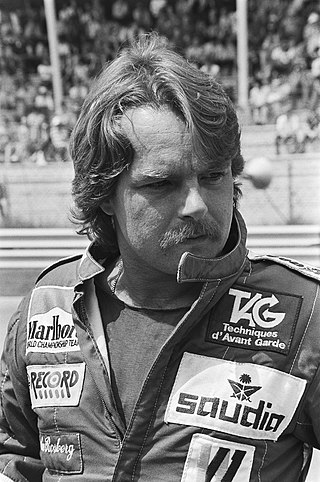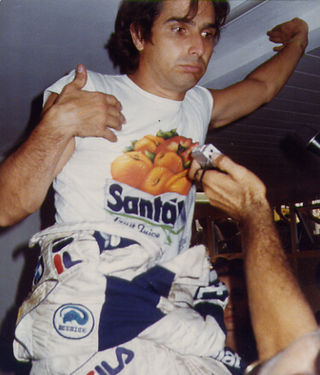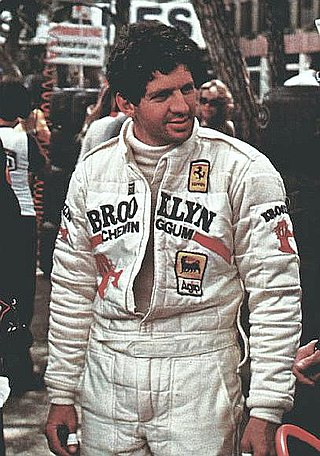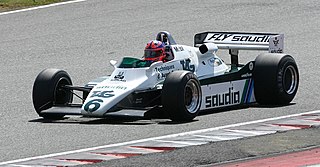
Williams Grand Prix Engineering Limited, currently racing in Formula One as Williams Racing, is a British Formula One team and constructor. It was founded by Sir Frank Williams (1942–2021) and Sir Patrick Head. The team was formed in 1977 after Frank Williams's earlier unsuccessful F1 operation: Frank Williams Racing Cars. The team is based in Grove, Oxfordshire, on a 60-acre (24 ha) site.

Keijo Erik Rosberg, known as "Keke", is a Finnish former racing driver and winner of the 1982 Formula One World Championship. He was the first Finnish driver to win the championship. He is the father of 2016 Formula One World Champion Nico Rosberg.

The Austrian Grand Prix is a Fédération Internationale de l'Automobile sanctioned motor racing event that was held in 1964, 1970–1987, 1997–2003, and then returned to the Formula One calendar in 2014.

The 1984 Dallas Grand Prix was a Formula One motor race held on July 8, 1984 at Fair Park in Dallas, Texas. It was the only running of the Dallas Grand Prix as a Formula One race, and the ninth race of the 1984 Formula One World Championship.

The 1985 British Grand Prix was a Formula One motor race held at Silverstone on 21 July 1985. It was the eighth race of the 1985 Formula One World Championship.

The 1985 Australian Grand Prix was a Formula One motor race held on the Adelaide Street Circuit in Adelaide on 3 November 1985. The sixteenth and final race of the 1985 Formula One World Championship, it was the 50th running of the Australian Grand Prix and the first to be held on the streets of Adelaide on a layout specifically designed for the debut of the World Championship in Australia. The race was held over 82 laps of the 3.780 km (2.362 mi) circuit for a total race distance of 310 kilometres. The race was won by Keke Rosberg driving a Williams-Honda; this was the final win for Rosberg, the last race for Alfa Romeo until 2019, and the last by a Finnish driver until Mika Häkkinen won the 1997 European Grand Prix.

The 1986 FIA Formula One World Championship was the 40th season of FIA Formula One motor racing. It featured the 1986 Formula One World Championship for Drivers and the 1986 Formula One World Championship for Manufacturers, both of which commenced on 23 March and ended on 26 October after sixteen races.

The 1985 FIA Formula One World Championship was the 39th season of FIA Formula One motor racing. It featured the 1985 Formula One World Championship for Drivers and the 1985 Formula One World Championship for Manufacturers, both of which commenced on 7 April and ended on 3 November after sixteen races.

The 1983 FIA Formula One World Championship was the 37th season of FIA Formula One motor racing. It featured the 1983 Formula One World Championship for Drivers and the 1983 Formula One World Championship for Manufacturers, which were contested concurrently over a fifteen-race series that commenced on 13 March and ended on 15 October.

The 1981 FIA Formula One World Championship was the 35th season of FIA Formula One motor racing. It featured the 1981 Formula One World Championship for Drivers and the 1981 Formula One World Championship for Constructors, which were contested concurrently over a fifteen-race series that commenced on 15 March and ended on 17 October. Formula One cars also competed in the 1981 South African Grand Prix, although this was a Formula Libre race and was not part of the Formula One World Championship.

The 1979 Formula One season was the 33rd season of FIA Formula One motor racing. It featured the 1979 World Championship of F1 Drivers and the 1979 International Cup for F1 Constructors which were contested concurrently over a fifteen-round series which commenced on 21 January 1979, and ended on 7 October. The season also included three non-championship Formula One races. Jody Scheckter of Scuderia Ferrari won the 1979 World Championship of F1 Drivers while Scuderia Ferrari won 1979 International Cup for F1 Constructors. Gilles Villeneuve made it a 1–2 for Ferrari in the championship, concluding a successful second half of the 1970s for Ferrari. Alan Jones finished the season strongly for Williams, finishing third in the championship and with teammate Clay Regazzoni scoring Williams's first ever Grand Prix win as a constructor. Scheckter's title was Ferrari's last drivers' title for 21 years, before Michael Schumacher won five consecutive titles for the team between 2000 and 2004.
Spirit Racing was a racing car constructor and racing team from the United Kingdom. Founded in 1981, it participated in the 1982 European Formula Two Championship, moved to Formula One in 1983, then competing in the 1988 F3000 season before finally folding at the end of that year. In 26 F1 races, its best finish was seventh at the 1983 Dutch Grand Prix.
The Japanese automobile manufacturer Honda has participated in Formula One, as an engine manufacturer and team owner, for various periods since 1964. Honda's involvement in Formula One began as a full team and engine entry in the 1964 season, and in 1965 they achieved their first victory at the Mexican Grand Prix. After further success with John Surtees, Honda withdrew at the end of the 1968 season due to difficulties selling road cars in the United States and Honda driver Jo Schlesser's fatal accident.

The McLaren MP4/2 was a Formula One car produced by McLaren for the 1984 season. An iteration of it, the MP4/2B, was used in the 1985 season, and a slightly updated version, the MP4/2C, raced in the 1986 season for McLaren. It was closely based on the MP4/1E model that was used as a test car, used in the final races of 1983.

The Lotus 99T is a Formula One car designed by Gérard Ducarouge for use by Lotus in the 1987 Formula One World Championship.

The Williams FW24 was the Formula One car with which the Williams team competed in the 2002 Formula One World Championship. It was driven by German Ralf Schumacher and Colombian Juan Pablo Montoya. Test drivers were Marc Gené, Giorgio Pantano and Antônio Pizzonia.

The Williams FW10 is a Formula One car designed by Frank Dernie for use by the Williams team in the 1985 Formula One World Championship. It was powered by a Honda RA165E V6 turbo engine and driven by Briton Nigel Mansell and Finn Keke Rosberg. An upgraded version of the car, dubbed the FW10B, was introduced late in the season, which enabled the team to win the final three races of the year.

The Williams FW08 was a Formula One car designed by Frank Dernie, which debuted at the 1982 Belgian Grand Prix held at the Zolder circuit. An evolution of the FW07 that it replaced, the car was used by Finnish driver Keke Rosberg to win the 1982 World Drivers' Championship.
The Ligier JS25 was a Formula One car designed by Michel Beaujon and Claude Galopin for use by the Ligier team during the 1985 Formula One season. Like its predecessor, the JS23, the JS25 was powered by a turbocharged Renault V6 engine although the car ran on Pirelli instead of Michelin tyres after the French company pulled out of Grand Prix racing at the end of 1984. Drivers of the car were initially their 1984 driver Andrea de Cesaris and veteran Jacques Laffite who returned to the team after two fruitless years at Williams, but after a series of crashes, de Cesaris was fired by team boss Guy Ligier and replaced by Philippe Streiff.

The Honda RA16 engine is a highly-successful and extremely powerful, turbocharged, 1.5-litre, 80-degree, V-6 racing engine, designed for use in Formula One; between 1983 and 1988. The customer engines were used by Spirit, Williams, Lotus, and McLaren.

















